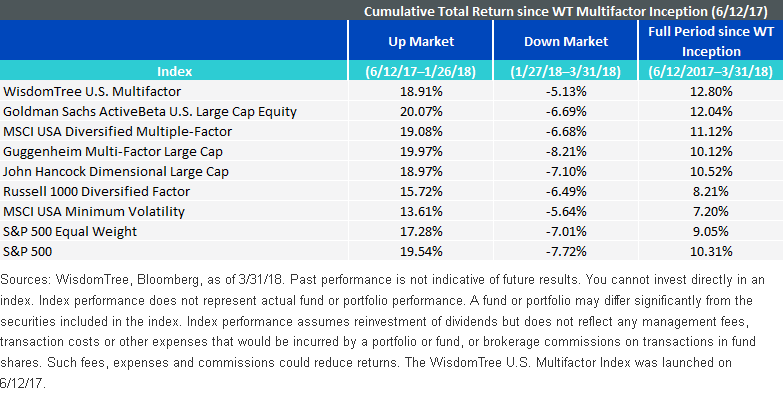
Many investors familiar with the exchange-traded fund (ETF) landscape will agree that multifactor strategies have become a central part of the investment conversation. WisdomTree pioneered this effort over a decade ago with a fundamental approach to indexing, but only recently did we launch the WisdomTree U.S. Multifactor Index, which directly seeks exposure to value, quality, momentum and low correlation, and indirectly provides size and low volatility exposure in a sector-neutral fashion. While investors still try to wrap their heads around these different multifactor strategies, we wanted to take advantage of the recent break from the bull market to compare and contrast real-time performance—in both up and down markets.
Since we launched our Index in June 2017, we have had sneak peaks into an up market, characterized by impressive stock returns and new market highs. We have recently also experienced vicious downdrafts in the market, accompanied by higher volatility. Below we display returns for a few of the multifactor indexes that serve as the underlying index for some of the largest multifactor ETFs. We also show returns for the WisdomTree U.S. Multifactor Index, which serves as the underlying Index for the WisdomTree U.S. Multifactor Fund (USMF). For context, we also include returns for the MSCI USA Minimum Volatility, S&P 500 Equal Weight, and S&P 500 indexes, during this roller-coaster period in U.S. equity markets.

Please see our glossary for definitions of indexes contained in the chart.
A Closer Look at Multifactor Index Performance
During the up-market trend, we were quite pleased with the ability of WisdomTree’s Index to keep pace with the S&P 500 Index. We say this because the latest up trend was characterized by some of the S&P 500’s largest names posting stellar returns. Our strategy, which contains a concentrated basket of 200 stocks, with about 45% of the Index’s weight distributed to mid-cap stocks,1 was nevertheless able to keep pace with the S&P 500 despite natural under-weights in these larger names. However, as the down market came over the last two months or so, and the large-cap beta trade broke down, stock selection again became advantageous. The 10-Year U.S Treasury yield over this period rose from 2.66% to 2.73%,2 providing meaningful headwinds for strategies like the MSCI USA Minimum Volatility Index, which tend to seek lower volatility by undertaking relative over-weights in defensive sectors such as Utilities and Consumer Staples. This is where the WisdomTree U.S. Multifactor Index truly shone, providing more downside protection than every other strategy shown here. Relative to the MSCI USA Minimum Volatility Index and the S&P 500 Index, respectively, this downside protection amounted to 51 and 259 basis points of outperformance over the two-month period.
















